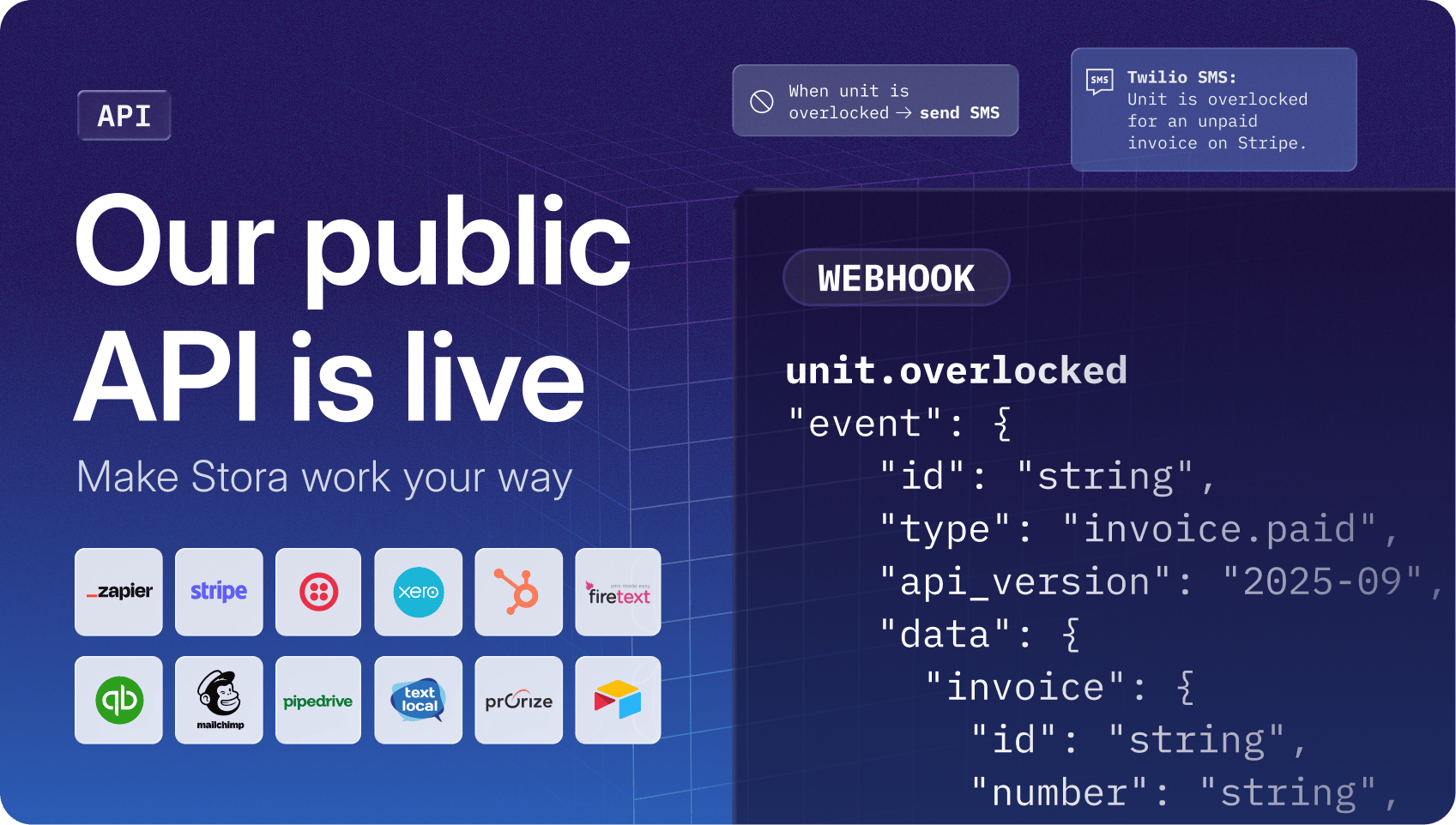Running a self storage business comes with endless moving parts. Managing bookings, tracking occupancy, chasing payments, and maintaining an excellent customer experience are challenging.
Without the right tools, these tasks can quickly become too much to handle on your own, especially as your competition grows and customer expectations rise. That’s where self storage management software can be helpful.
The demand for these platforms is high. The global self storage software market is expected to reach $1.55 billion in 2025 and climb to $5.66 billion by 2035, growing at a rate of about 13.8% each year.
That growth means one thing is for sure: Self storage operations that embrace technology gain a serious competitive advantage.
Whether you run a small self storage facility with 50 units or oversee multiple sites with hundreds of tenants, the right software helps you simplify business operations, improve efficiency, and ultimately increase profitability.
In this article, we’ll unpack what self storage management software is, why you need it, and how it can help you run a stable, profitable business.
What Is Self Storage Management Software?
Self storage management software automates many of the repetitive administrative tasks that are required in the daily running of a self storage business.
This includes tasks such as assigning units to tenants, tracking availability, managing site and unit access, communicating with tenants, creating invoices, and collecting payments.
Before self storage management software was available, these tasks were done manually by facility managers. And they were completed, tracked, and reported on through a combination of hand-filled forms, paper-filled customer files in cabinets, ledgers, bulletin boards, and whiteboards. This also involved endless phone calls to and from customers and banks.
As technology has evolved, operators have adopted computerisation, relieving some of this load by using multiple pieces of separate software together.
This often includes Excel spreadsheets, Word documents, a customer database, and an accounting package like Quicken, to manage operations.
Surprisingly, many operators today still use basic, dated, and siloed digital methods like these, unaware of how much unnecessary effort they and their staff are putting into this everyday admin.
Modern self storage management software doesn’t just digitise more tasks; it combines the functionality from multiple pieces of software into a single, convenient platform.
Then, it upgrades and accelerates operations by fully automating entire business processes along the customer and operational lifecycles, from lead-generation to move-out and sale to reporting.
Why You Need Self Storage Management Software
Running a self storage company involves more than just renting out a unit. The best self storage software gives you a competitive advantage, helping you streamline operations, reduce errors, and deliver a better customer experience. Here are just some of the reasons why your business needs this technology:
Save time and reduce manual work
For many self storage operators, juggling spreadsheets, phone calls, and paper contracts is the norm. But these manual processes are time-consuming and prone to mistakes.
Self storage management software automates repetitive tasks like invoicing, payment reminders, and unit availability updates.
This frees up your time to focus on higher-value work, such as sales and customer service, while also ensuring fewer errors.
Gain real-time data and insights
Decisions based on outdated information can hurt your growth. Self storage management software typically provides real-time data on occupancy rates, rental income, and customer activity.
With accurate insights at their fingertips, self storage owners can quickly adjust pricing, run promotions, or expand their facilities based on demand.
Having instant access to data also makes it easier to identify potential issues, such as overdue payments or low occupancy rates, before they escalate.
Improve the tenant experience
Storage tenants want simplicity and convenience. The best self storage software allows them to reserve units, sign contracts, and pay for their storage unit online in just a few clicks.
This not only improves customer satisfaction but also reduces friction for your staff. Features like automated reminders, digital access controls, and online account management keep tenants in the loop while minimising unnecessary admin work for your team.
Seamlessly integrate with other tools
It’s possible that you currently rely on multiple systems, like accounting software, payment gateways, smart access control, and online marketing platforms.
A key benefit of self storage management software is that it can seamlessly integrate with these tools.
This creates a single, connected system where information flows smoothly between systems, eliminating the need for duplicate data entry and helping your business run more efficiently.
Scale your business with confidence
As your business grows, managing multiple sites or hundreds of storage units becomes increasingly complex. Without the right technology, scaling can quickly lead to operational bottlenecks and dissatisfied tenants.
Self storage management software makes it easier to replicate success across your various locations by standardising processes, centralising data, and ensuring consistent tenant experiences across all your facilities.
The Different Types of Self Storage Management Software
Now that you know more about this software and why you need it, let’s unpack the main types of self storage management systems for you to investigate:
Desktop software
Older, legacy software products tend to offer only a desktop solution, which is also called on-premises software.
This means the software is downloaded directly onto each computer at your facility and doesn’t require an internet connection to use it.
However, this type of software can use a lot of storage space on your machine, and this increases as you create more tenant accounts and files over time.
You will often need to buy a copy of the software for each computer it’s loaded on, and be aware that some desktop software will only run on certain operating systems. For example, it may run on Windows computers but not on an Apple device.
Also, because you can only use it on the computers on which it’s been installed, this can limit where staff can work, constraining them to working at one facility, office, or some other fixed location to manage business tasks.
Desktop software often comes with large upfront costs, and installing updates can be challenging.
Web or cloud-based software
In contrast, modern technology now offers businesses the option of web-based or cloud software.
With this type of system, the software lives online, and you use a browser and a login to access it. This means you can manage your business from any computer with an internet connection, whenever and wherever.
Payment is usually subscription-based, so upfront capital expenditure is minimal. If you’re a new business, getting started with your new software can cost less and will scale as you grow.
Some providers may offer tiers with a maximum number of user accounts included, while others will offer unlimited staff logins, no restriction on how many users can access the system at once, and no additional licence fees per staff member.
Making Your Self Storage Software Decision
Choosing the right self storage management software is one of the most important investments you’ll make for your business.
The platform you select will impact how efficiently your company runs, how smoothly tenants interact with your facility, and how easily you can grow over the next few years.
While it may be tempting to simply pick the most affordable option or the first system that looks good, this decision requires careful thought and planning.
Below are some of the core features and considerations to weigh up before making your choice, as well as how Stora can support your self storage operations:
Look for comprehensive automation
Automation is a necessity for your self storage business. The best self storage software should automate everyday tasks such as invoicing, late payment reminders, gate access control, and vacancy updates.
These features save you time, reduce errors, and free up your staff from repetitive manual work.
When evaluating software options, ask yourself: Will this system eliminate the bottlenecks that slow me down today?
With Stora, automation is built into the core of our platform, helping you manage bookings, payments, and tenant communication without the hassle of manual admin tasks.
Prioritise ease of use
Storage management software is only valuable if your team and tenants can actually use it. A cluttered or overly technical interface can slow adoption and frustrate your staff.
Look for software with a clean, intuitive dashboard that requires minimal training.
Tenants should be able to navigate the system effortlessly, with simple processes for reserving a storage unit, signing a contract, and paying online.
Our software is designed with simplicity in mind, offering a modern, user-friendly experience for both self storage operators and tenants.
Evaluate scalability and longevity
Consider whether your current platform can support your growth, whether that means expanding to new sites, adding hundreds of new units, or introducing new services like mobile storage.
A system that works today but can’t scale tomorrow will create costly disruptions down the line.
With Stora, you get software that scales with you, from single-site operators to multi-facility self storage facilities.
Check for real-time reporting
As mentioned above, data drives better business decisions. The right self storage management platform should give you live data on occupancy, revenue, unit availability, and tenant behaviour.
Detailed reporting and analytics help you spot trends, adjust your pricing, and maximise profits. Without these insights, you’ll be operating blind in an increasingly competitive market.
Our software delivers powerful reporting tools that give you instant visibility into the metrics that matter most to your business, such as revenue, sales, occupancy, and customer acquisition through marketing channels.
Look for integration capabilities
As mentioned earlier, many self storage operators already use a variety of tools, from accounting software to payment gateways and marketing platforms.
The right self storage management system should integrate with these systems to create a connected ecosystem for your business. This is important because it reduces duplicate work, improves accuracy, and ensures smooth communication between your different platforms.
Stora integrates with a huge variety of your favourite tools and apps, including leading payment processors, marketing platforms, and smart access control systems, helping your business run efficiently from day one.
Prioritise the customer experience and tenant convenience
Your tenants expect convenience at every step. Your software should support online reservations, digital contracts, self-service portals, and flexible payment options.
Some platforms even allow tenants to manage their entire rental journey, from booking a unit to making payments, without ever speaking to staff.
This not only improves the tenant experience but also reduces your overheads because you don’t have to hire a huge team to manage these aspects of running your facility.
With Stora, your tenants get a seamless, fully digital experience, helping you stand out from your competitors.
Consider security and compliance
Self storage security isn’t just about locks and gates. Protecting tenant data is equally critical.
The software you choose should include secure payment processing, encrypted data storage, and compliance with industry regulations.
Make sure your provider is proactive about updates and cybersecurity, as a single breach can damage both tenant trust and your reputation.
Weigh up the cost and value for money
Of course, price is always a factor, especially if you’re just starting out. However, it should never be your only deciding factor.
Some self storage platforms may appear affordable upfront, but lack essential features, leading to hidden costs later on.
Instead, consider the platform's overall value: How much time will it save your team? How much revenue can it help generate through improved occupancy and efficiency?
Understand vendor support and ongoing development
Finally, consider the company behind the software you’re choosing. Do they provide training and onboarding? Is customer support responsive and knowledgeable? Are they actively improving their product to keep up with the industry?
The right software provider will be there to support you long after the initial sale.
Here at Stora, our team works closely with storage operators to provide fast, helpful support, and we’re continuously improving our platform based on customer feedback.
The Questions to Ask Yourself When Choosing Your Software Solution For a detailed look at the key questions you should ask vendors when comparison shopping, and why, make sure to read our guide on Choosing Self Storage Management Software: What to Ask. |
Use the Best Self Storage Management Software to Simplify Your Operations Today
Self storage management software has the power to transform the way you run your facility. By automating routine tasks, reducing overheads, and giving tenants the convenience they expect, you create a leaner, more efficient business model that’s easy to scale.
Stora has been designed to give self storage owners an all-in-one platform that covers everything from online bookings and payments to access control and reporting.
Our software allows you to simplify day-to-day operations, improve the tenant experience, and scale quickly, no matter the size of your facility.
For example, our CEO, Gavin, has a fully automated self storage business himself, comprising two sites, both of which are using Stora.
If you’re looking for the best self storage software to future-proof your business, book a Stora demo today. We’ll show you how our software can simplify your operations and give you more time to focus on growing your business.








